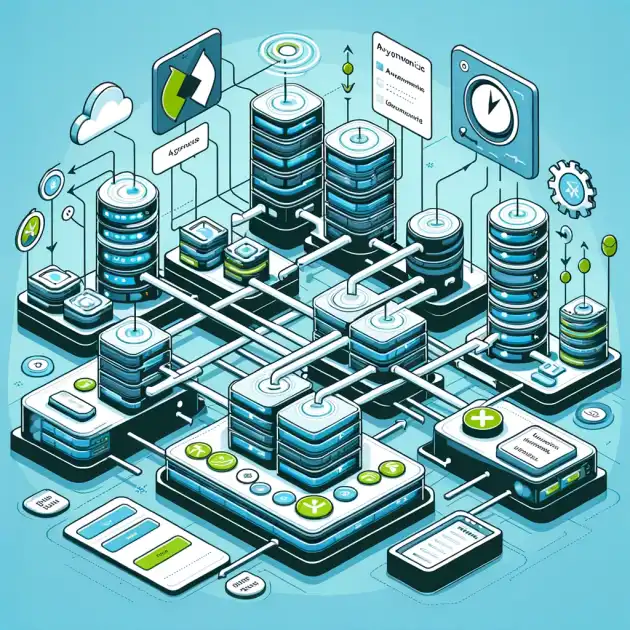In the world of distributed systems and microservices architecture, communication is key. But not all communication is created equal. Today, we'll dive into the world of asynchronous communication, with a focus on a powerful tool that's become a staple in this space: Apache Kafka.
What is Asynchronous Communication?
Asynchronous communication is a method where the sender and receiver do not need to interact with the message at the same time. This is different from synchronous communication, where the sender waits for an immediate response from the receiver. In asynchronous communication, the message is sent, and the sender can continue with other tasks, not waiting for an immediate response.
This non-blocking nature of asynchronous communication is essential for distributed systems and microservices architecture. It allows for more efficient use of resources and can help to improve the scalability and performance of a system.
Examples of Asynchronous vs Synchronous Communication
- Direct Messaging (DM) vs Email: DMs are often synchronous, with an expectation of an immediate response, while emails are asynchronous, allowing the recipient to respond at their convenience.
- HTTP vs AJAX: HTTP requests are typically synchronous, blocking the user until a response is received. AJAX, on the other hand, allows for asynchronous requests, improving the user experience by not blocking the user interface.
- Remote Procedure Call (RPC) vs Message Queues/PubSub: RPC is a synchronous communication method, while message queues and PubSub (Publish-Subscribe) systems enable asynchronous communication, decoupling the sender and receiver.
Use Cases for Asynchronous Communication
- Traditional Request/Response Queues: Used for decoupling request and response processing.
- Messaging: Enables communication between different parts of a system without requiring a direct connection.
- Event Streaming: Useful for tracking object creation and updates in real time.
- Stream Processing: Supports data aggregation and analytics, as well as pipeline processing.
Asynchronous communication also allows for multiple clients on either side to push or pull data, increasing parallelism and enabling real-time analytics concurrently with hot-path processing.
What is Apache Kafka?
Apache Kafka is a real-time event streaming platform, named after the Bohemian novelist Franz Kafka. Developed by LinkedIn and open-sourced in January 2011, it has since become a widely adopted tool for asynchronous communication. Written in Scala and Java, Kafka is known for its high throughput and low latency capabilities. It supports various security mechanisms and is backward and forward compatible (after version 0.10.0).
Kafka is used by numerous companies across different industries, including LinkedIn, Uber, PayPal, Spotify, Netflix, Airbnb, and many others, including banks and tech giants.
The Kafka Platform
Kafka consists of several components:
- Kafka Broker (Server): Acts as the central server that clients interact with.
- Kafka Client Java/Scala Library: Provides the API for clients to interact with the Kafka broker.
- Kafka Streams: A stream processing library.
- Kafka Connect: A framework for connecting Kafka with external systems.
- MirrorMaker: A tool for replicating data between Kafka clusters.
Kafka offers several APIs, including the Admin API, Producer API, Consumer API, Streams API, and Connect API. Additionally, open-source libraries exist for various programming languages, including C/C++, Python, Go, Node.js, Rust, Kotlin, and many more.
Kafka Basic Concepts
Understanding Kafka requires familiarity with its basic concepts:
- Message (Event or Record): The basic unit of data in Kafka, consisting of a key, value, timestamp, and headers.
- Partition: A sequence of messages within a topic, ordered and immutable.
- Topic: A category to which messages are published, consisting of one or more partitions.
- Producer: An entity that publishes messages to a Kafka topic.
- Consumer: An entity that subscribes to and consumes messages from a Kafka topic.
- Broker: A server that stores messages and manages communication between producers and consumers.
Managed Kafka Providers
There are several managed Kafka providers, including Confluent Cloud, Amazon MSK, and Azure Event Hubs, each with its own set of features and limitations.
Summary
Asynchronous communication is a cornerstone of distributed systems and microservices architecture, offering the ability to process messages without blocking. Apache Kafka stands out as an advanced message broker platform that provides strong ordering and durability guarantees, making it an excellent choice for high-throughput, big data scenarios. With its wide range of use cases and extensive support for different programming languages, Kafka continues to be a popular choice for developers and organizations looking to harness the power of asynchronous communication.
